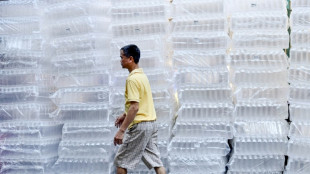
-
 Head defiant as India sense victory in first Australia Test
Head defiant as India sense victory in first Australia Test
-
Scholz's party to name him as top candidate for snap polls

-
 Donkeys offer Gazans lifeline amid war shortages
Donkeys offer Gazans lifeline amid war shortages
-
Court moves to sentencing in French mass rape trial

-
 'Existential challenge': plastic pollution treaty talks begin
'Existential challenge': plastic pollution treaty talks begin
-
Cavs get 17th win as Celtics edge T-Wolves and Heat burn in OT

-
 Asian markets begin week on front foot, bitcoin rally stutters
Asian markets begin week on front foot, bitcoin rally stutters
-
IOC chief hopeful Sebastian Coe: 'We run risk of losing women's sport'

-
 K-pop fans take aim at CD, merchandise waste
K-pop fans take aim at CD, merchandise waste
-
Notre Dame inspired Americans' love and help after fire

-
 Court hearing as parent-killing Menendez brothers bid for freedom
Court hearing as parent-killing Menendez brothers bid for freedom
-
Closing arguments coming in US-Google antitrust trial on ad tech

-
 Galaxy hit Minnesota for six, Orlando end Atlanta run
Galaxy hit Minnesota for six, Orlando end Atlanta run
-
Left-wing candidate Orsi wins Uruguay presidential election

-
 High stakes as Bayern host PSG amid European wobbles
High stakes as Bayern host PSG amid European wobbles
-
Australia's most decorated Olympian McKeon retires from swimming

-
 Far-right candidate surprises in Romania elections, setting up run-off with PM
Far-right candidate surprises in Romania elections, setting up run-off with PM
-
Left-wing candidate Orsi projected to win Uruguay election

-
 UAE arrests three after Israeli rabbi killed
UAE arrests three after Israeli rabbi killed
-
Five days after Bruins firing, Montgomery named NHL Blues coach

-
 Orlando beat Atlanta in MLS playoffs to set up Red Bulls clash
Orlando beat Atlanta in MLS playoffs to set up Red Bulls clash
-
American McNealy takes first PGA title with closing birdie

-
 Sampaoli beaten on Rennes debut as angry fans disrupt Nantes loss
Sampaoli beaten on Rennes debut as angry fans disrupt Nantes loss
-
Chiefs edge Panthers, Lions rip Colts as Dallas stuns Washington

-
 Uruguayans vote in tight race for president
Uruguayans vote in tight race for president
-
Thailand's Jeeno wins LPGA Tour Championship

-
 'Crucial week': make-or-break plastic pollution treaty talks begin
'Crucial week': make-or-break plastic pollution treaty talks begin
-
Israel, Hezbollah in heavy exchanges of fire despite EU ceasefire call

-
 Amorim predicts Man Utd pain as he faces up to huge task
Amorim predicts Man Utd pain as he faces up to huge task
-
Basel backs splashing the cash to host Eurovision

-
 Petrol industry embraces plastics while navigating energy shift
Petrol industry embraces plastics while navigating energy shift
-
Italy Davis Cup winner Sinner 'heartbroken' over doping accusations

-
 Romania PM fends off far-right challenge in presidential first round
Romania PM fends off far-right challenge in presidential first round
-
Japan coach Jones abused by 'some clown' on Twickenham return

-
 Springbok Du Toit named World Player of the Year for second time
Springbok Du Toit named World Player of the Year for second time
-
Iran says will hold nuclear talks with France, Germany, UK on Friday

-
 Mbappe on target as Real Madrid cruise to Leganes win
Mbappe on target as Real Madrid cruise to Leganes win
-
Sampaoli beaten on Rennes debut as fans disrupt Nantes loss

-
 Israel records 250 launches from Lebanon as Hezbollah targets Tel Aviv, south
Israel records 250 launches from Lebanon as Hezbollah targets Tel Aviv, south
-
Australia coach Schmidt still positive about Lions after Scotland loss

-
 Man Utd 'confused' and 'afraid' as Ipswich hold Amorim to debut draw
Man Utd 'confused' and 'afraid' as Ipswich hold Amorim to debut draw
-
Sinner completes year to remember as Italy retain Davis Cup

-
 Climate finance's 'new era' shows new political realities
Climate finance's 'new era' shows new political realities
-
Lukaku keeps Napoli top of Serie A with Roma winner

-
 Man Utd held by Ipswich in Amorim's first match in charge
Man Utd held by Ipswich in Amorim's first match in charge
-
'Gladiator II', 'Wicked' battle for N. American box office honors

-
 England thrash Japan 59-14 to snap five-match losing streak
England thrash Japan 59-14 to snap five-match losing streak
-
S.Africa's Breyten Breytenbach, writer and anti-apartheid activist

-
 Concern as climate talks stalls on fossil fuels pledge
Concern as climate talks stalls on fossil fuels pledge
-
Breyten Breytenbach, writer who challenged apartheid, dies at 85


Japan's century of efforts to tame earthquakes
Takashi Hosoda was in a Tokyo skyscraper when the 9.0 magnitude quake struck on March 11, 2011, but the trained architect was "not particularly worried" as modern Japanese buildings are designed to protect their occupants.
A century after Tokyo was destroyed in the Great Kanto Earthquake of 1923, the Japanese capital today bears no resemblance to the city levelled by that 7.9 tremor, which killed 105,000 people.
The low-rise, largely wooden city that was destroyed a second time by US firebombing during World War II has been replaced by a soaring megalopolis where reinforced concrete is king.
The September 1, 1923, disaster marked "the dawn of seismic design of structures in Japan", said Yoshiaki Nakano, an earthquake engineering expert from the National Research Institute for Earth Sciences and Disaster Resilience (NIED).
The following year Japan introduced its first building code for earthquake-resistant construction.
These standards have been constantly expanded since then, drawing on lessons from other major tremors in the archipelago, which accounts for around 10 percent of the world's earthquakes.
Japan's seismic building code is one of the most stringent in the world, Nakano told AFP.
"Basically, the Japanese building requires a relatively higher strength" than elsewhere, he said, stressing the importance of meticulous monitoring of compliance.
"The system to supervise and check the design and the construction on-site is a very key factor to ensure the quality of the structure, the performance of the building during earthquakes," he said.
The 2011 earthquake triggered a deadly tsunami along the northeast coast but in Tokyo the damage was limited: high-rise towers oscillated alarmingly for several minutes but did not topple.
- Skyscraper shock absorbers -
Early basic reinforced structures have been adapted with more sophisticated seismic safety measures found in modern towers.
Massive soft rubber cushions are installed under the foundations to isolate them from ground vibrations; shock absorbers are distributed throughout the floors; and some even have pendulums weighing several hundred tonnes installed at the top to counteract the movement of the building during a quake.
Built in 2014 and rising 247 metres (810 feet) above the city, the Toranomon Hills Mori Tower is fitted with such seismic anti-vibration systems, including 516 oil dampers, each comprising a thick cylinder 1.7 metres long.
"It stretches and shrinks repeatedly in case of an earthquake. It then starts getting warm, which means the energy of the quake transforms into heat and gets released," Kai Toyama, a structural engineering official at real estate giant Mori Building, told AFP.
"As a result, the tremor of the whole building can be controlled."
After the Kobe earthquake in 1995 left more than 6,000 dead, emphasis was also placed on strengthening earthquake resistance standards for new wooden houses and upgrading older buildings dating from before the last major overhaul of the building code in 1981.
The Great Kanto Earthquake of 1923 was also "a wake-up call to Japan", Nakano noted. "Not only the engineers but also for people."
Since 1960, Japan has marked September 1 as national Disaster Prevention Day.
Every year on that day, countless schoolchildren, employees and civil servants -- including the entire government -- carry out simulation exercises in preparation for a major earthquake.
In Japan, many people stock emergency supplies at home, as do businesses and local governments. As of April 1, 2023, local authorities in Tokyo have stockpiled 9.5 million instant meals (comprising rice, noodles and biscuits) in about 400 warehouses.
- Still vulnerable -
These precautionary measures were intensified after the 2011 earthquake, which caused huge traffic jams in Tokyo and the suspension of public transport, preventing millions of people from returning home, said Hosoda, now head of disaster management at Mori Building.
Despite all these efforts, some experts say Tokyo remains vulnerable to earthquakes, and even more to other natural disasters such as floods.
The eastern districts of the capital are built on unstable and flood-prone soils, and there are still concentrations of old wooden dwellings attached to each other.
Post-war rebuilding of Tokyo was "anarchic" and "prioritised economic development and not the construction of a resilient city", seismologist Masayuki Takemura lamented during a recent press conference.
He also pointed to an "excessive concentration of skyscrapers" and the construction of residential areas on artificial islands, increasing their risk of isolation in the event of a natural disaster.
And experts say there is a 70 percent chance of a major earthquake hitting Tokyo within the next 30 years.
Y.Bouchard--BTB




